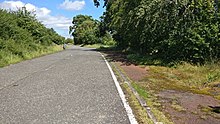
Back Assassinats de la Miami Showband Catalan Miami Showband hilketak Basque Dúnmharú an Miami Showband (1975) Irish טבח מיאמי שואובאנד HE Miami Showband-morden Swedish
| Miami Showband killings | |
|---|---|
| Part of the Troubles | |
 Site of the massacre; a commemorative plaque shows where the band's minibus was parked in the lay-by | |
| Location | A1 road at Buskhill, County Down, Northern Ireland |
| Coordinates | 54°15′37″N 6°18′57″W / 54.2603°N 6.3159°W |
| Date | July 31, 1975 2:30 am (BST) |
Attack type | Bombing, shooting |
| Weapons | L2A3 submachine gun, Luger pistol |
| Deaths | 3 band members 2 Ulster Volunteer Force (UVF) members |
| Injured | 2 band members |
| Perpetrators | UVF Mid-Ulster Brigade |
The Miami Showband killings (also called the Miami Showband massacre)[1] was an attack on 31 July 1975 by the Ulster Volunteer Force (UVF), a loyalist paramilitary group. It took place on the A1 road at Buskhill in County Down, Northern Ireland. Five people were killed, including three members of The Miami Showband, who were one of Northern Ireland's most popular cabaret bands.
The band was travelling home to Dublin late at night after a performance in Banbridge. Halfway to Newry, their minibus was stopped at what appeared to be a military checkpoint where gunmen in British Army uniforms ordered them to line up by the roadside. At least four of the gunmen were soldiers from the British Army's Ulster Defence Regiment (UDR), and all were members of the UVF. Two of the gunmen, both soldiers, died when a time bomb they were hiding on the minibus exploded prematurely. The other gunmen then started shooting the dazed band members, killing three and wounding two. It has been suggested that the bomb was meant to explode en route, so that the victim band members would appear to be Irish Republican Army (IRA) bomb smugglers and stricter security measures would be established at the border.
Two serving UDR soldiers and one former UDR soldier were found guilty of the murders and received life sentences; they were released in 1998. Those responsible for the attack belonged to the Glenanne gang, a secret alliance of loyalist militants, Royal Ulster Constabulary (RUC) police officers and UDR soldiers. There are also allegations that British military intelligence agents were involved. According to former Intelligence Corps agent Captain Fred Holroyd, the killings were organised by British intelligence officer Robert Nairac, together with the UVF Mid-Ulster Brigade and its commander Robin "the Jackal" Jackson. The Historical Enquiries Team investigated the killings and released their report to the victims' families in December 2011. It confirmed that Jackson was linked to the attack by fingerprints.
The massacre dealt a blow to Northern Ireland's live music scene, which had brought young Catholics and Protestants together. In a report published in the Sunday Mirror in 1999, Colin Wills called the Miami Showband attack "one of the worst atrocities in the 30-year history of the Troubles". Irish Times diarist Frank McNally summed up the massacre as "an incident that encapsulated all the madness of the time".
- ^ Dillon 1991, p. 174
© MMXXIII Rich X Search. We shall prevail. All rights reserved. Rich X Search
